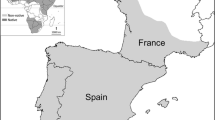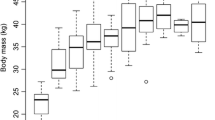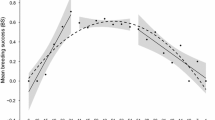Abstract
Studies on wild Eurasian lynx (Lynx lynx) have revealed variation in reproduction between areas, years and individuals. In order to explore potential causes for this variation other than food supply, we analysed data from captive lynx, which provide conditions with minimal environmental variation as all were fed ad libitum. Data from 37 individual female lynx were available from 20 zoos in Norway, Sweden, Finland, Switzerland and the Czech Republic. Data on 177 reproductive events (where a male was available to the female at mating time) are presented. Of these events, 85% resulted in litters being born. Average litter size was 1.95, with a variation from 1 to 4. The mean birth date was 26th May, and sex ratio was not significantly different from parity. The probability of reproduction was related to age, with fewer litters produced by the very young (2–3-year old), and no sign of a senescence effect. However, a clear effect of senescence on litter size was evident. The captive lynx did not have higher reproductive rates than wild lynx, indicating that either factors other than food supply are driving the variation in wild lynx reproduction, or that a factor such as stress may be causing additional variation in the captive population.
Similar content being viewed by others
References
Andersen R, Linnell JDC, Odden J, Andrén H, Sæther B-E, Moa P, Herfindal I, Kvam T, Brøseth H (2003) Utredninger i forbindelse med ny rovviltmelding. Gaupe—Bestandsdynamikk, bestandsutvikling og høstingstrategier. Reports for the large Predator Policy Statement. Lynx—population dynamics, population development and harvesting strategies. NINA-Fagrapport 59 (in Norwegian with English abstract)
Berger J (1999) Anthropogenic extinction of top carnivores and interspecific animal behaviour: implications of the rapid decoupling of a web involving wolves, bears, moose and ravens. Proc R Soc Lond B 22:2261–2267
Breitenmoser-Würsten C, Zimmermann F, Ryser A, Capt S, Laass J, Siegenthaler A, Breitenmoser U (2001) Untersuchungen zur Luchspopulation in der Nordwestalpen der Schweiz 1997–2000. Kora Bericht No. 9
Brown JL, Terio KA, Graham LH (1996) Fecal androgen metabolite analysis for non-invasive monitoring of testicular steroidogenic activity in felids. Zoo Biol 15:425–434
Buchanan KL (2000) Immunosuppression under stress; necessary for condition-dependent signalling? Reply. Trends Ecol Evol 15:4197
Burnham KP, Anderson DR (1998) Model selection and interference: a practical information-theoretic approach. Springer, New York Berlin Heidelberg
Carlstead Kl, Brown JL, Monfort SL, Killens R, Wildt DE (1992) Urinary monitoring of adrenal responses to psychological stressors in domestic and nondomestic felids. Zoo Biol 11:165–176
Carlstead KL, Brown JL, Seidensticker J (1993) Behavioural and adrenocortical responses to environmental changes in Leopard cats (Felis bengalensis). Zoo Biol 12:321–331
Charleworth B (1980) Evolution in age-structured populations. Cambridge University Press, Cambridge
Clutton-Brock TH (1984) Reproductive effort and terminal investment in iteroparous animals. Am Nat 123:212–229
Clutton-Brock TH (1988) Reproductive success. Studies of individual variation in contrasting breeding systems. University of Chicago Press, Chicago
Engen S, Sæther B-E (2003) Demographic stochasticity and Allè effects in populations with two sexes. Ecology 84:2378–2386
Gaillard J-M, Yoccoz NG (2003) Temporal variation in survival of mammals: a case of environmental canalization? Ecology 84:3294–3306
Gaillard J-M, Andersen R, Delorme D, Linnell JDC (1998) Family effects on growth and survival of juvenile roe deer. Ecology 79:2878–2889
Gaillard J-M, Festa-Bianchet M, Yoccoz NG, Loison A, Toïgo C (2000) Temporal variation in fitness components and population dynamics of large herbivores. Annu Rev Ecol Syst 31:367–393
Gaillard J-M, Loison A, Festa-Bianchet M, Yoccoz NG, Solberg E (2003) Ecological correlates of life span in populations of large herbivorous mammals. Popul Develop Rev 29(Suppl):39–56
Ghalambor CK, Martin TE (2001) Fecundity-survival trade-offs and parental risk-taking in birds. Science 292:494–497
Hewison M, Gaillard J-M (2001) Phenotypic quality and senescence affect different components of reproductive output in roe deer. J Anim Ecol 70:600–608
Hurlbert SH (1984) Pseudoreplication and the design of ecological field experiments. Ecol Monogr 54:187–211
Kaczensky P (1991) Untersuchungen zur Raumnutzung weiblicher Luchse (Lynx lynx), sowie zur Abwanderung und Mortalität ihrer Jungen im Schweizer Jura. Diplomarbeit Forstwissenschaftliche Fakultät Universität München
Kvam T (1990) Population biology of the European lynx (Lynx lynx) in Norway. Dr. Scient thesis. Department of Zoology, University of Trondheim
Kvam T (1991) Reproduction in the European lynx, Lynx lynx. Z Säugetierkunde 56:146–158
Lande R, Engen S, Sæther B-E (2003) Stochastic population dynamics in ecology and conservation. Oxford University Press, Oxford
Lindemann W (1955) Über die Jungendentwicklung beim Luchs (Lynx l. lynx Kerr) und bei der Wildkatze (Felis s silvestris Schreb.). Behaviour 8:1–46
Lindström J, Kokko H (2002) Cohort effects and population dynamics. Ecol Lett 5:338–344
Liptrap RM (1993) Stress and reproduction in domestic animals. Ann NY Acad Sci 697:275–283
Marker-Kraus L, Grisham J (1993). Captive breeding of cheetahs in North American zoos (1987–1991). Zoo Biol 12:5–18
Morato RG, Conforti VA, Azevedo FC, Jacomo ATA, Silveira L, Sana D, Nunes ALV, Guimaraes MABV, Barnabe RC (2001) Comparative analyses of semen and endocrine characteristics of free-living versus captive jaguars (Panthera onca). Reproduction 122:745–751
Morato RG, Verreschi ITN, Guimaraes MABV, Cassaro K, Pessuti C, Barnabe RC (2004) Seasonal variation in the endocrine-testicular function of captive jaguars (Panthera onca). Theriogenology 61:1273–1281
Newton I (1989) Lifetime reproduction in birds. Academic Press, London
Pulliainen E, Lindgren E, Tunkari PS (1995) Influence of food availability and reproductive status on the diet and body condition of the European lynx in Finland. Acta Theriol 40:181–196
Puschmann W (1983) Wildtiere in Menschenhand. Säugetiere, Berlin
R Development Core Team (2004). R: A language and environment for statistical computing. R foundation for Statistical Computing, Vienna, Austria. ISBN 3-900051-07-0, URL http://www.R-project.org, http://r.project.org
Ricklefs RE, Wikelski M (2002) The physiology/life-history nexus. Trends Ecol Evol 17:462–468
Roelke ME, Martenson JS, O’Brien SJ (1993) The consequences of demographic reduction and genetic depletion in the endangered Florida panther. Curr Biol 3:340–350
Sæther B-E, Engen S (2004) Stochastic population theory faces reality in the laboratory. Trends Ecol Evol 19:351–353
Stearns SC (1992) The evolution of life histories. Oxford University Press, Oxford
Stehlik J (2000) Reproductive biology of the European lynx, Lynx lynx (Linnaeus, 1758) at Ostrava Zoo. Zool Garten NF 70:351–360
Stenseth NC, Shabbar A, Chan K-S, Boutin S, Rueness EK, Ehrich D, Hurrell JW, Lingjærde OC, Jacobsen KS (2004) Snow conditions may create an invisible barrier for lynx. Proc Natl Acad Sci USA 101:10632–10634
Swanson WF, Brown JL (2004) International training programs in reproductive sciences for conservation of Latin American felids. Anim Reprod Sci 82–83:21–34
Swanson WF, Johnson WE, Cambre RC, Citino SB, Quigley KB, Brousset DM, Morais RM, Moreira N, O’Brien SJ, Wildt DE (2003) Reproductive status of endemic felid species in Latin American zoos and implications for ex situ conservation. Zoo Biol 22:421–441
Tella JL (2001) Sex-ratio theory in conservation biology. Trends Ecol Evol 16:76–77
The Eurasian Lynx Studbook (Lynx lynx) 1997. Compiled by Elin Lundstrøm, Stockholm. University, SPARKS, 29 October 1997
Trivers RL, Willard DE (1973) Natural selection of parental ability to vary the sex ratio of offspring. Science 179:90–92
Tumanov IL (2000) Peculiarities of Lynx lynx breeding and postnatal ontogenesis. Zool Zhurnal 79:763–766
Vaupel JW, Yashin AI (1985) Heterogeneity’s ruses: some surprising effects of selection on population dynamics. Am Stat 39:176–185
Von Arx M, Breitenmoser-Würsten Ch, Zimmermann F, Breitenmoser U (2004) Status and conservation of the Eurasian lynx (Lynx lynx) in Europe in 2001. KORA-Bericht, 19. http://www.kora.unibe.ch/en/proj/elois/online/
Wildt DE, Bush M, Goodrowe KL, Packer C, Pusey AE, Brown JL, Joslin P, O’Brien SJ (1987) Reproductive and genetic consequences of founding isolated lion populations. Nature 329:328–331
Wildt DE, Monfort SL, Donoghue AM, Johnston LA, Howard J (1992) Embryogenesis in conservation biology—or, how to make an endangered species embryo. Theriogenology 37:161–184
Wingfield JC, Breuner CW, Honey P, Jacobs J, Lynn S, Maney D, Ramenofsky M, Richardson R (1998) Ecological bases of hormone-behavior interactions: the “emergency life history stage”. Am Zool 38:191–206
Author information
Authors and Affiliations
Rights and permissions
About this article
Cite this article
Henriksen, H.B., Andersen, R., Hewison, A.J.M. et al. Reproductive biology of captive female Eurasian lynx, Lynx lynx. Eur J Wildl Res 51, 151–156 (2005). https://doi.org/10.1007/s10344-005-0104-1
Received:
Accepted:
Published:
Issue Date:
DOI: https://doi.org/10.1007/s10344-005-0104-1




